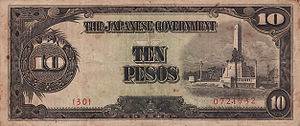- Japanese government-issued Philippine fiat peso
-
Japanese government-issued Philippine fiat peso Peso (English), (Tagalog), (Spanish) 
Obverse of the 10 pesos note, 1944-1945 User(s)  Second Philippine Republic
Second Philippine RepublicSubunit 1/100 Cent
Centavo or Céntimo (Spanish)
Sentimo (Tagalog)Symbol ₱ Plural pesos Banknotes 1₱, 5₱, 10₱, 50₱, 100₱, 500₱, 1000₱ Central bank Japanese government This infobox shows the latest status before this currency was rendered obsolete. During World War II in the Philippines, the occupying Japanese government issued fiat currency in several denominations; this is known as the Japanese government-issued Philippine fiat peso. The Japanese-sponsored Second Philippine Republic under Jose P. Laurel outlawed possession of guerrilla currency, and declared a monopoly on the issuance of money, so that anyone found to possess guerrilla notes could be arrested.
Some Filipinos called the fiat peso "Mickey Mouse money". Many survivors of the war[who?] tell stories of going to the market laden with suitcases or "bayong" (native bags made of woven coconut or buri leaf strips) overflowing with the Japanese-issued bills. According to one witness, 75 "Mickey Mouse" pesos, or about 35 U.S. dollars at that time, could buy one duck egg.[1] In 1944, a box of matches cost more than 100 Mickey Mouse pesos.[2]
These bills were often used by American psychological warfare personnel as propaganda leaflets. Japanese occupation banknotes were overprinted with the words "The Co-prosperity Sphere: What is it worth?", in an attempt to discredit the Greater East Asia Co-Prosperity Sphere, and dropped from Allied aircraft over the occupied territories.[3]
Contents
Denominations
1942 series
1944-45 series
A new series of 1, 5, and 10 peso bills was issued in 1943. Hyperinflation had also forced the Japanese to issue 100, 500, and 1000 peso notes in 1944.
See also
- Emergency circulating notes
- Japanese government-issued dollar in Malaya, North Borneo, Sarawak and Brunei
- Philippine peso
References
- ^ Barbara A. Noe (August 7, 2005). "A Return to Wartime Philippines". Los Angeles Times. http://www.latimes.com/news/local/valley/la-tr-philippines7aug07,0,648886,full.story?coll=la-editions-valley. Retrieved 2006-11-16.[dead link]
- ^ Agoncillo, Teodoro A. & Guerrero, Milagros C., History of the Filipino People, 1986, R.P. Garcia Publishing Company, Quezon City, Philippines
- ^ Friedman, Herbert A.. "WWII Allied Propaganda Banknotes". http://www.psywarrior.com/WWIIAlliedBanknotes.html. Retrieved 2010-04-17.
External links
 Philippine peso and coinage
Philippine peso and coinageTopics Bangko Sentral ng Pilipinas · Philippine real · Philippine peso fuerte · Japanese occupation note · Emergency circulating notes · English Series · Pilipino Series · Ang Bagong Lipunan Series · New Design seriesCurrent series 1¢ • 5¢ • 10¢ • 25¢ • ₱1 • ₱5 • ₱10₱20 • ₱50 • ₱100 • ₱200 • ₱500 • ₱1000Obsolete denominations 20¢ • 50¢ • ₱2Small currency denomination notes (English series) • ₱1 • ₱2 • ₱5 • ₱10Currencies named peso or similar Circulating Argentine peso · Chilean peso · Colombian peso · Cuban convertible peso · Cuban peso · Dominican peso (peso oro) · Macanese pataca (圓) · Mexican peso · Philippine peso (piso) · Uruguayan pesoObsolete Argentine peso argentino · Argentine peso ley · Argentine peso moneda corriente · Argentine peso moneda nacional · Bolivian peso · Catalan peseta (pesseta) · Costa Rican peso · Ecuadorian peso · Equatorial Guinean peseta · Guatemalan peso · Guinea-Bissau peso · Honduran peso · Japanese government-issued Philippine fiat peso · Nicaraguan peso · Paraguayan peso · Peruvian peseta · Portuguese Timorese pataca · Puerto Rican peso · Sahrawi peseta · Salvadoran peso · Spanish peso · Spanish peseta (pesseta, pezeta) · Venezuelan pesoSee also Categories:- Peso
- Japanese invasion money
- Home front during World War II
- Military history of the Philippines during World War II
- Currencies of the Philippines
Wikimedia Foundation. 2010.
